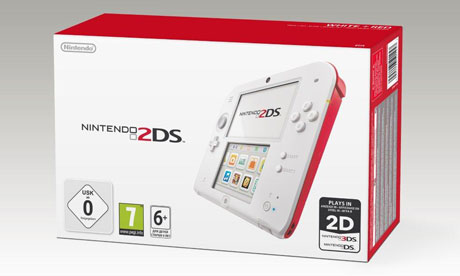Responses have been mixed to say the very least. TechCrunch called it "hideous", Wired went for "weird", but NIntendo is hoping the new 2DS handheld console will work alongside the Wii U price cut to boost sales in the crucial Christmas season.
For those who missed the news yesterday, the 2DS is a cheaper version of the controversial 3DS handheld, launched back in 2011. Set for release on 12 October in Europe, the new machine features the same internal hardware as the 3DS, but with no stereoscopic 3D functionality, and with a new slate design replacing the hinged "clam shell" configuration that has characterised the DS range. The twin displays will have the same sizes as the original 3DS screens (3.5 inches for the top display, 3 inches for the lower), and the dual camera lenses on the backside have been retained – so strangely, it'll take stereoscopic photos, but you'll need to transfer them to a 3DS to view them in full.
Wireless internet connection has also been maintained, allowing the popular StreetPass and SpotPass social connectivity features to be maintained. The machine will be available in red and white or black and blue colour schemes and is expected to retail at £110, £30 to £35 less than the cheapest 3DS offers.
Speaking to US gaming site Kotaku on Wednesday, the Nintendo of America president, Reggie Fils-Aime, described the console as "an entry-level handheld gaming system", opening up the technology to cash-strapped families this Christmas. But many sites have read the move as an acceptance that the 3D gaming experiment has been a disappointing mis-step. Since its launch two-and-a-half years ago, the 3DS has shifted about 33m units, but the original DS machine had sold more than 45m units within the same amount of time. During the launch period of the machine, many newspapers including the Sun alleged that the stereoscopic screens were causing nausea for a large number of gamers, while Nintendo itself issued a health warning advising against the viewing of stereoscopic effects for children under seven. These elements, together with the comparatively high launch price, acted as a deterrent to the sort of family-focused purchasers who helped make the DS such a huge success.
The move comes at a time in which enthusiasm for home 3D technology is waining. Although sales of 3D television sets grew by more than 70% in 2012 according to industry research specialist DisplaySearch, it seems as though consumers are not making use of the functionality after purchase. In July, the BBC revealed that its 3D programming would be put on indefinite hold, while ESPN is shutting down its 3D content by the end of 2013. Both have cited lack of public interest as their motivation. Furthermore, although a range of Playstation 3 and Xbox 360 gameswere released with stereoscopic modes during the major hype period of 3D TV sales, very few developers are now supporting the technology. Gamer apathy and disappointing results have been the key explanations.
Meanwhile in the games industry, Nintendo is losing ground to its rivals Sony and Microsoft who both have new next-gen machines out in November. The PlayStation 4 and Xbox One are much more powerful than the Wii U and their head-to-head hype war has led to impressive pre-orders for both contenders, leaving Wii U and 3DS in the shade. At the same time, Nintendo's handheld console is having to complete against smartphones and tablets as well as the PlayStation Vita, a more advanced handheld gaming device that may well receive a boost thanks to its close compatibility with the PS4.
Analysts understand Nintendo's thinking, but responses have been as mixed as the game sites. "The launch of the 2DS makes sense," said Piers Harding-Rolls, head of games at IHS Electronics and Media. "Unlike Sony with its PS Vita, this younger consumer is Nintendo's core user for its handhelds, and the 3DS, while performing better since 2012, is still relatively expensive and also able to display 3D, which carries a warning for younger children. Launching a cheaper, non-3D, non-hinged product plugs the gap left in Nintendo's portfolio created by the decline of its original DS platform."
Brian Blau, a research director at Gartner, understands the strategy, but feels its more about treading water rather than boosting competitiveness in the market. "While the 3D part of the 3DS was interesting there was some concern about the screen and the 3D content," he said. "It's possible that removing these components was enough of a cost saving but didn't take away from the overall 3DS experience or sacrifice the core game and app capability. I don't believe this new device (or the price cuts on Wii U) will have that much impact on their overall performance in the market, but it could help them keep the units moving and games being played."
There will also be questions regarding the admittedly small selection of 3DS titles that really utilise the stereoscopic features. What sort of experience will 2DS owners get from games like Super Mario 3D World and Pilot Wings Resort that make 3D visuals a key part of the navigation and gameplay?
While the Nintendo 3DS is certainly not in the same league of three-dimensional failure as the infamous Virtual Boy device, which was launched in 1995 to near universal criticism, the arrival of the 2DS suggests the manufacturer's confidence in its gadget has taken a hit. And with Wii U sales also disappointing, this will prove a challenging Christmas for the video game veteran.


No comments:
Post a Comment